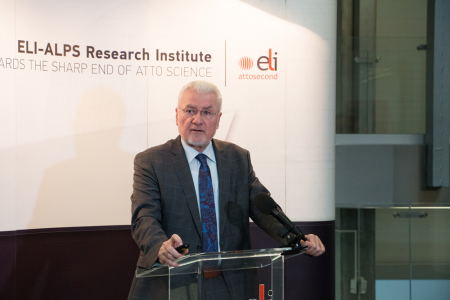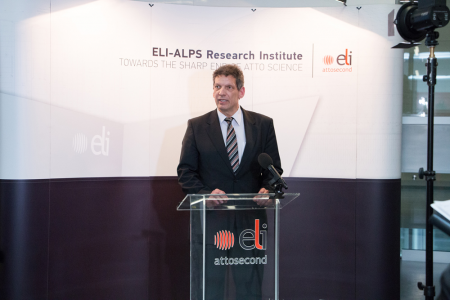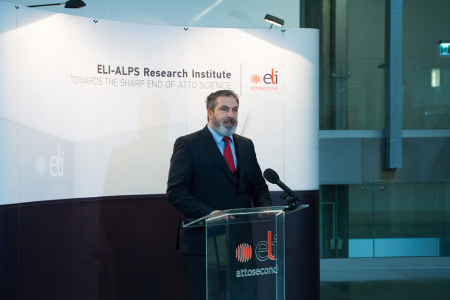As the operating costs of the laser research centre would be covered to a large extent from the membership fees of countries partnering with the consortium to have access to the research capacities, it is essential to effectively communicate the research opportunities of the equipment to potential research groups. The total investment cost of the centre, which also serves research in medicine and materials science, is HUF 80 billion (EUR 260 million). The second phase of the project was implemented from more than HUF 40 billion in funding, 85% of which was provided by the European Regional Development Fund.
In the press conference at the ELI laser research centre in Szeged, József Pálinkás, President of the National Research, Development and Innovation Office, which exercises the owners’ rights over the research centre, pointed out: “The internationally unique research infrastructure has been implemented on time, within budget and in line with the planned technical parameters.” The recently started experiments are expected to convince further research groups that the ELI-ALPS (Extreme Light Infrastructure Attosecond Light Pulse Source) is a world-class laser research equipment which can contribute to promising research achievements.
The research infrastructure of the laser centre primarily serves discovery research projects and is open to scientists from all over the world to conduct their experiments in Szeged. In the building which was delivered last May, the first experimental equipment was put into operation in late October by ELI-ALPS researchers and their partners and manufacturers. This January, the first external, foreign users of the laser facility arrived from Switzerland. The first phase of their experiments, being also the first live test of the laser equipment, has been successfully concluded. Led by Hans Jacob Wörner, the research group of Swiss university of technology ETH Zurich, used the so-called HR1 (High Repetition Rate) laser system of ELI-ALPS to produce the first high harmonic spectrum in noble gases which suggests the presence of attosecond pulses. In the process researchers focused infrared laser pulse into noble gas filled gas cells or gas jets to change the characteristic parameters of light and create higher frequency pulses. In the continuation of the research project, the created high harmonic pulses will be used to examine ultrafast physical processes in liquid molecules.
At the same time, the researchers of the Szeged laser centre and the Greek F.O.R.T.H. (Foundation for Research and Technology – Hellas) have managed to generate high harmonics in crystals using the mid-infrared laser of the research centre. The project examines the quantum mechanical aspects of the high harmonic generation (HHG) process by measuring photon statistics in the laser space of the drive after the generation. The project combines two areas of research: strong-field physics and quantum optics.
Károly Osvay, research technology director at ELI-HU Nonprofit Kft underlined: “The successful beginning of experiments by the first group of professional users prove that our lasers run reliable for real, and it is also a milestone in getting prepared for receiving professional users."
Lóránt Lehrner, managing director of ELI-HU Nonprofit Kft said: “The arrival of the first cooperating partners as users is significant step in our project, and we consider their research achievements as a common success. We are happy to see them satisfied with the infrastructure and professional expertise ELI has to offer."
The members of the international ELI consortium, the Czech, Romanian and Hungarian laser centres, agreed in December 2017 to apply jointly for the ERIC (European Research Infrastructure Consortium) qualification which would facilitate the involvement of foreign research groups as external users in the long-term maintenance of the research infrastructure. The consortium form not only enables more effective coordination of services provided to the researcher community but also makes it possible to cover a large portion of operating costs from the contributions of organisations desiring to use the research capacities and thus joining the consortium.
From 2019, similarly to the researchers of other countries, Hungarian researchers will also have to compete for having access to the research equipment, that is for the so-called “beam time” by submitting applications to a scientific committee. In order to make the ELI laser research centre in Szeged attractive to the international researcher community, strong Hungarian research groups are absolutely necessary, so the NRDI Office has launched a HUF 1 billion (EUR 3.3. million) funding programme called “ELI Related Experimental Research National Programme” to support Hungarian researchers. Grantees are primarily expected to perform experiments as scientific users. This may include the development of equipment closely related to the discovery research mission of the ELI.
 |
| József Pálinkás, president of the National Research, Development and Innovation Office |
 |
| Károly Osvay, research technology director at ELI-HU Nonprofit Kft. |
 |
| Lóránt Lehrner, managing director of ELI-HU Nonprofit Kft. |
Szeged, 12 February 2018






